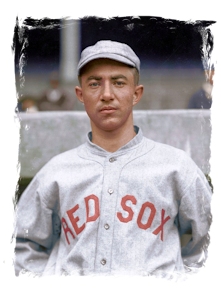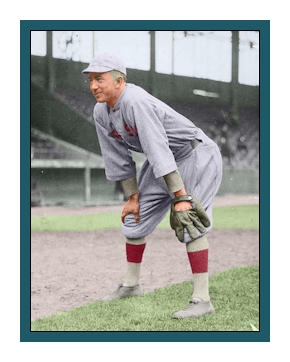|
“FENWAY'S BEST PLAYERS”  |
|||||
James McAleer, a native of Youngstown and minority owner of the Boston Red Sox of the American League (AL), noticed Scott playing for the Youngstown Steelmen. On McAleer's suggestion, the Red Sox purchased Scott from Youngstown in 1913, and optioned him to the St. Paul Saints of the Class AA American Association. Scott, who batted and threw right-handed, arrived with a great advance buildup in Boston in 1914; even the great Connie Mack of the Philadelphia Athletics was impressed by his fielding prowess after an early season game against the Red Sox. On Opening Day, April 14, he played his first big league game, succeeding the incumbent, Heinie Wagner. His rookie year .239 batting average was good for a shortstop during this era, and his fielding was good enough, too. He cut his errors almost in half in his second season with the Red Sox. Bill Phillips, manager of the Indianapolis Hoosiers of the outlaw Federal League, attempted to convince Scott to jump from the AL after the 1913 season, but Scott remained with the Red Sox. Scott made his major league debut on April 14, 1914 for the Red Sox. The Red Sox named Scott team captain for the 1921 season, after the previous captain, Harry Hooper, was traded to the Chicago White Sox. Scott had started at short for the 1915, ’16 and ’18 Red Sox World Championship teams. In all, he played for Boston for eight seasons, averaging .246 during that span. In 1915, his steady defense was one of the main reasons why the Red Sox advanced to the World Series, defeating the Philadelphia Phillies in five games. Scott had just one hit, a single, in 18 Series at-bats. The 1916 Sox returned to the World Series once more and they defeated the Brooklyn Robins in five games. For the season, Scott had improved his batting average to .232, as well as being the American League leader in fielding average for shortstops. Wilbert Robinson of the Robins nicknamed him “Trolley Wire,” a tribute to his accurate throws from shortstop to first during the Series. Scott was 2-for-16 with one RBI in the 1916 Series. After two world championships in his first three years, Scott felt he deserved more money and sent back the contract the Red Sox offered to him for the 1917 season, which (after the collapse of Federal League competition) had offered a slight decrease in salary. However, within a few days, Scott came to terms with the Red Sox and earned a substantial raise, from $3,000 to $4,500. Beginning with an abridged spring training, the 1918 season was directly affected by World War I. Players were not able to get into game condition, resulting in many lame arms among pitchers. In addition, the Army’s provost marshal, General Enoch Crowder, issued a ”work or fight'' order that required eligible men of draft age to enlist in the armed services or find work in war-related industries. Some 237 players left their teams during the season. However, neither Scott nor teammate Harry Hooper missed a league game all season and, by the time the World Series against the Chicago Cubs was played, the two players were the only position players left from Boston’s 1916 championship team. Although the 1919 season was a disappointment for the Red Sox, Scott hit a career-high .278 and led all American League shortstops in fielding. In the five years after World War I ended, Red Sox owner Harry Frazee sold off many members of the Red Sox championship teams to pay his debts. The Yankees came out of most of those deals so far ahead of the Red Sox, that the Yankee dynasty of the 20s clearly was linked to the Red Sox dynasty of the 1910s. The Red Sox began spring training in 1920 with a team in transition, held together by Scott, Hooper, and John “Stuffy” McInnis. Despite their efforts, the Boston club eventually finished 25 1/2 games behind the American League champion Cleveland Indians. Just before Christmas in 1921, Frazee made yet another deal with New York. A total of seven players were involved in the transaction including each team’s starting shortstop. Boston got New York’s Roger Peckinpaugh and then quickly traded him to Washington for another future Yankee, Jumpin' Joe Dugan. New York got Everett Scott from the Red Sox. He absolutely loved playing in Boston and I do mean “loved playing,” because at the time of his trade to new York, he had played in a then Major League record of 830 consecutive games. In 1920, Scott played in 154 games, amassing a career-high 210 total bases, with four home runs and 61 RBIs. During the season, he passed the 533 consecutive games mark of the Phillies’ Fred Luderus, hitting a rare home run in the process. On April 26 he broke the record of 577 consecutive games played set by George Pinckney of Brooklyn from 1885 to 1890, and played his 600th straight game on July 14. Early in 1921 spring training, Scott suffered a charley horse injury that lingered throughout the spring training schedule. However, the injury did not stop his streak, which reached 700 on May 17, in a game during which he made a phenomenal force out by diving face first into second base. Stating a goal of attaining the 1,000 mark, he played in number 800 on September 2. Still esteemed by fans and press alike, Scott continued to be praised for his consistency in the field and at bat. It was strongly felt that his record for consecutive games was unbeatable. That streak would not end until May 5, 1925, during Scott’s fourth and final season with New York, when Yankee Manager, Miller Huggins decided his shortstop needed to rest a sore back. At the time he had played in 1,307 consecutive games. Just a couple weeks later, Scott’s Yankee teammate, a young first baseman named Lou Gehrig began a consecutive game playing streak that would eventually overwhelm Scott’s achievement. The player they called “Deacon” was not much of a hitter but he was one of baseball’s best defensive shortstops during his day. And although he didn’t hit for average, Scott barely struck out, making him a valuable hit-and-run weapon. He was also very smart and worked very hard at his craft. That’s probably why Miller Huggins made the guy a Yankee Captain. Old Everett added a fourth World Series ring to his collection in 1923, as a key member of the first-ever Yankee team to win the Fall Classic. In all he played thirteen big league seasons in five different uniforms and hit .249 lifetime.
|
|||||

